MINE CREEK STATE HISTORIC SITE TOUR
Use this arrow to learn more at each stop.
This tour was underwritten by the Institute of Museum & Library Services.

This walking tour will guide you through the Mine Creek State Historic Site, located at 20485 KS-52
Pleasanton, KS 66075. Each stop is marked by a numbered wooden stake.
Continue scrolling right once you are arrive at Mine Creek.
DIRECTIONSContinue scrolling right once you are arrive at Mine Creek.
You are now at the site of the only battle fought in the state of Kansas during the American Civil War. This battle is considered by many to be the largest cavalry battle of the entire war. More than 6,000 Confederate cavalrymen from the divisions of Marmaduke and Fagan formed a line of battle just north of Mine Creek. Facing them about 1,000 yards to the north were about 2,500 Federal cavalrymen from the brigades of Philips and Benteen. Mine Creek is a small stream but the ford along the Fort Scott Road is difficult and dangerous. Both banks are steep (10 to 25 feet) and treacherous. The ford had a rocky bottom but the far side bank was steep and was now slippery after most of Price's wagon train had already gotten across. The other two available fords have muddy bottoms and are generally not passable by wagons during wet weather.

The Visitor center has a number of interpretive displays explaining Price's Missouri Expedition. Inside the Mine Creek Battlefield visitor center you'll see Civil War-era uniforms, learn about the eyewitnesses to the battle, and see weapons from the battle. The best part of the site is the interpretive walking trail out in the middle of the battlefield. The 1.6 mile Prairie Loop passes through the area of the battlefield north of Mine Creek. The 1.2 mile Timber Loop traverses the area south of Mine Creek.
Make sure you get a copy of the Walking Trail Brochure. The next eleven tour stops follow the tour along this walking trail. There is another excellent brochure called the Battle of Mine Creek Kansas. It contains maps that show the location of the roads that existed in 1864 relative to the roads present today. This brochure is a great reference to use during the remainder of the tour. For more information, please see the incredible research done by author Dick Titterington and his The Civil War Muse Website. Also, you can obtain his books at Amazon here or by contacting his website.

It was the morning of October 25, 1864. The situation for Price's Army was precarious. It was strung out over a distance of 8 miles from Mine Creek to the Little Osage River. Price himself was encamped at the head of the column about eight miles south along with Shelby's Division. He planned to attack Fort Scott and capture what government stores were there. Marmaduke's Division had been given responsibility as rear guard for the retreating Confederate army. Marmaduke was back at Mine Creek dealing with a difficult situation there.
Around 11:00 A.M. Marmaduke found that the Mine Creek crossing was blocked. Because of the heavy rains, the creek was a raging torrent. The two available fords were backed up with over 100 wagons still trying to get across. To further complicate matters, a wagon had overturned and was now blocking the ford. Marmaduke had planned to get across and set up his rear-guard defense on the south side of Mine Creek. But now Marmaduke knew he needed to hold off the advancing Federals from the north bank until the remaining wagons could get across the creek. He sent word back to get support from Fagan's division.
Scroll down to continue the tour.
Previous slide
Next slide
Stop 1
Skirmish Ridge
DIRECTIONSSkirmish Ridge
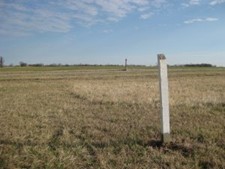
You are standing about where the Fort Scott Road passed through here. Turn and look to the north. In the distance is a red marker. The Confederates had set up their skirmish line here to delay the advancing Federals. Following the engagement at The Mounds, Philips' and Benteen's Brigades had continued the pursuit with Philips in the lead. They had followed the Fort Scott Road south. Around 11:00 A.M. on October 25, 1864, Philips' Brigade came over the ridge to the north and drove back the Confederate skirmishers. Philips immediately saw the Confederate rear guard forming its line of battle north of Mine Creek with its artillery ready. Philips formed on the right and waited for Benteen to arrive.
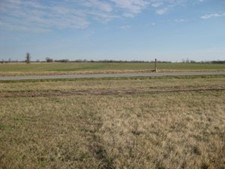
Turn around and look to the south. Take note of the terrain - it's rolling prairie, the perfect topography for a cavalry engagement. The entire field was tall prairie grass with only some small trees along the creek.

Previous slide
Next slide
Stop 2
Positions Along the Fort Scott Road
DIRECTIONSPositions Along the Fort Scott Road

You are standing on Fort Scott Road in between the opposing forces. Take a moment to think about the troops that were just about ready to start fighting. It's about 11:00 A.M. on the morning of October 25, 1864. Marmaduke had originally planned to get across the stream and set up his rear-guard defense on the south side of Mine Creek. He felt he would be able hold off the Federals from that position. But just before 11:00 A.M., Marmaduke had found that the Mine Creek crossing was blocked. Because of the heavy rains the creek was a raging torrent. The two available fords were backed up with over 100 wagons still trying to get across. To further complicate matters, a wagon had overturned and was now blocking the ford.
Marmaduke realized he would have to set up his defense line on the north side of the creek. He deployed Clark's and Freeman's Brigades as a rear guard. The Confederate line extended about 800 yards and contained about 4,825 men. At this point Philips' Brigade came across a ridge about 1,000 yards north of the Confederates. As the Federals came into view, Marmaduke requested assistance from Fagan's Division. Fagan had gotten all of his division south of Mine Creek except for Cabell's Brigade. After Marmaduke's request, Cabell's Brigade immediately deployed into the line of battle. Cabell was about to order a charge when Benteen's Brigade joined Philips to the north.
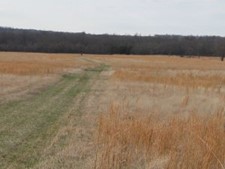
Fagan brought the rest of his division across to the north side of the creek and extended the Confederate line west. Marmaduke felt he was now confronted by an overwhelming force and sent back a request to Price for reinforcements. Neither Marmaduke nor Fagan deployed any of their troops as a reserve force.
Look to the south. Off in the distance there are two red markers. The marker directly south of you marks the initial Confederate line of battle across Fort Scott Road. There is another red marker to the southeast (it may be difficult to pick out from where you are standing) that marks the right flank of the Confederate line. The Confederate line of battle extended about three quarters of a mile to the west from this marker.
Look to the south. Off in the distance there are two red markers. The marker directly south of you marks the initial Confederate line of battle across Fort Scott Road. There is another red marker to the southeast (it may be difficult to pick out from where you are standing) that marks the right flank of the Confederate line. The Confederate line of battle extended about three quarters of a mile to the west from this marker.
Confederate troop locations to the South
Brigadier General John B. Clark Jr.'s Brigade (about 1,450 men) from Marmaduke's Division was on the Confederate right flank. His troops extended from the left red marker to just east of the red marker to your immediate south. Hynson's Texas Battery (two 10 pound Parrotts) was deployed on the right flank (near the red marker to your left).
Colonel Thomas R. Freeman's Brigade (about 1,000 men) from Marmaduke's Division was deployed on Clark's left on the Fort Scott Road. Harris' Battery (two 10 pound Parrotts and one six pounder) was deployed at the center of the line near where the center red marker stands. You are standing just to the north of their position.
Colonel Thomas R. Freeman's Brigade (about 1,000 men) from Marmaduke's Division was deployed on Clark's left on the Fort Scott Road. Harris' Battery (two 10 pound Parrotts and one six pounder) was deployed at the center of the line near where the center red marker stands. You are standing just to the north of their position.
Brigadier General William L. Cabell's Brigade (about 2,100 men) from Fagan's Division was deployed just left of center and extended to the little hillock about 100 yards north of a north bend in Mine Creek. Blocher's Arkansas Battery (two guns) was on the Confederate left flank.
Colonel W. F. Slemmons' Brigade (about 800 men) from Fagan's Division was deployed to Cabell's left.
Colonel Archibald S. Dobbin's Brigade (about 500 men) from Fagan's Division was deployed with Slemmons on the Confederate Left flank.
Colonel W. F. Slemmons' Brigade (about 800 men) from Fagan's Division was deployed to Cabell's left.
Colonel Archibald S. Dobbin's Brigade (about 500 men) from Fagan's Division was deployed with Slemmons on the Confederate Left flank.
Confederate troop locations to the North
Brigadier General John B. Clark Jr.'s Brigade (about 1,450 men) from Marmaduke's Division was on the Confederate right flank. His troops extended from the left red marker to just east of the red marker to your immediate south. Hynson's Texas Battery (two 10 pound Parrotts) was deployed on the right flank (near the red marker to your left).
Colonel Thomas R. Freeman's Brigade (about 1,000 men) from Marmaduke's Division was deployed on Clark's left on the Fort Scott Road. Harris' Battery (two 10 pound Parrotts and one six pounder) was deployed at the center of the line near where the center red marker stands. You are standing just to the north of their position.
Colonel Thomas R. Freeman's Brigade (about 1,000 men) from Marmaduke's Division was deployed on Clark's left on the Fort Scott Road. Harris' Battery (two 10 pound Parrotts and one six pounder) was deployed at the center of the line near where the center red marker stands. You are standing just to the north of their position.
Now turn and look to the north at the Federal position. Up on the hill by the red marker was the Federal line of battle.
Union troop locations to the North
Philips immediately saw that the Federals were outnumbered. They were facing more than 6,000 Confederates along with their artillery. He sent back a request to Pleasanton for reinforcements. Philips' Brigade came under Confederate artillery fire and became pinned down. Philips' artillery returned this fire.
Previous slide
Next slide
Stop 3
Union Artillery Position
DIRECTIONSUnion Artillery Position
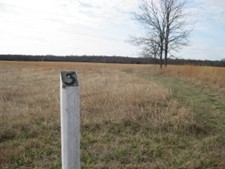
Once the Federal attack began, a section from the Second Missouri Light Artillery (two 3-inch Ordnance Rifles) advanced to the spot near where you are standing. They were positioning themselves to be able to fire on the Confederate positions more accurately.

As it turns out, this pair of guns actually ended up friendly-firing at two companies of Federals from the Fourth Iowa Cavalry Regiment that had been able to get around the Confederate right flank. Fortunately, there were few casualties that resulted from this fire.

Previous slide
Next slide
Stop 4
Union Cavalry Charge
DIRECTIONSUnion Cavalry Charge

Curiously, Marmaduke and Fagan had not set out the Confederate line of battle to defend a well-mounted cavalry charge. When cavalry attack, they do so at a relatively narrow point in the enemy lines. Their objective is to break through the enemy lines and then continue the attack from behind the enemy lines. But Marmaduke and Fagan had not set up an effective reserve force to counteract a successful break in their lines by the attacking Federal cavalry. It could be argued that Marmaduke was constrained because of the wagon train that had still not gotten completely across Mine Creek.
The Federals' Firepower
Because of the impact on the battle's outcome, let's take a moment to discuss how the Federal cavalrymen were armed. Remember that most of the Confederates were armed with single shot muzzle-loading rifles, not particularly well-suited for mounted cavalrymen. Philips' Brigade was armed with the 15-shot repeating Henry Rifle and each man also carried a revolver. All the men in Benteen's Brigade were armed with the 7-shot repeating Spencer Carbine, a revolver and a saber. The arms of Benteen's Brigade were particularly well suited for a cavalry charge. The arms of the men in Philips' Brigade gave them overwhelming fire power against the Confederates. They would end up supporting the initial charge by Benteen with this fire power.

As soon as he arrived on the field of battle, Benteen realized the Confederates were in a difficult situation with their backs to Mine Creek. He quickly decided an all-out, immediate charge was the correct move. He formed to the left of the Fort Scott Road in a column of four regiments across a 400 yard front:
- Tenth Missouri Regiment was first in the attack column
- Fourth Iowa Regiment was second in the attack column
- Third Iowa Regiment was third in the attack column
- Seventh Indiana and Fourth Missouri Regiments combined were fourth in the attack column
Benteen sent a message to Philips asking him to support his attack and began his charge in a south-southwesterly direction. Philips' Brigade also moved out in support. There had been a 300 - 400 yard gap between the Federal brigades to begin with, but this disappeared because both brigades charged at an angle and closed the gap. There were 2,500 cavalrymen charging straight at the Confederate lines. This may well have been the largest cavalry charge of the entire war. The Confederate artillery was firing cannister at the charging Federals. When they were within 300 yards of the Confederates, Benteen called out for the buglers to sound charge. You are standing near where the Federal charge began.
However, about 100 yards into the charge the Federal Tenth Missouri Regiment in Benteen's Brigade stopped the charge out of fear. Of course, this caused the charging regiments behind them to stop causing a lot of disorganization in the Federal lines. Benteen was screaming at them to continue the charge. At this point, Philips' Brigade also stopped charging about 300 yards from the enemy. They dismounted and began firing at the Confederates. At this point, the Confederates could have turned the tables on the Federals, but they were not advancing.
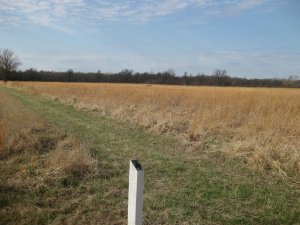
Previous slide
Next slide
Stop 5
Charging Federals Hit Confederate Line
DIRECTIONSCharging Federals Hit Confederate Line

Major Abial R. Pierce in command of the Fourth Iowa Regiment was stuck behind the halted Tenth Missouri. He decided that he needed to move to his left to get around the "traffic jam." He was successful and ordered the regiment to charge the Confederate right flank. As they charged forward, two companies, A and K, of the Fourth Iowa had to move further left to avoid a ravine blocking their movement forward. In veering left they were able to flank the Confederate position. The Fourth Iowa Regiment attacked Clark's Brigade from the rear and sent the Confederates retreating in disarray. The rest of Benteen's Brigade followed the lead of the Fourth Iowa and charged the Confederates. At this point Philips' Brigade remounted and charged the Confederate left.
Now you have reached the Confederate line and are standing where the Union Cavalry charge crashed into the Confederate defenders. Just to the east of where you are standing was Clark's Brigade from Marmaduke's Division. Just to the west was Freeman's Brigade from Marmaduke's Division.
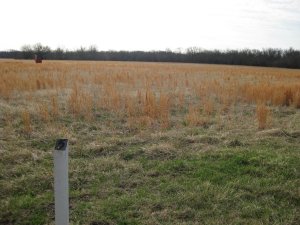
If you look to the southeast, you can almost see Union Major Abial R. Pierce leading the Fourth Iowa Regiment and hitting Clark's Brigade from the rear. Freeman's Brigade would turn and run before the charging Federals even reached them. Earlier they had suffered many casualties from the withering fire at the hands of Philips' dismounted brigade. Their retreat exposed Cabell's right flank to the attacking Federals. The Seventh Missouri State Militia (MSM) Regiment commanded by Lt. Colonel T. T. Crittenden broke through the right center and flanked Cabell's Brigade.

Previous slide
Next slide
Stop 6
The Confederate Retreat
DIRECTIONSThe Confederate Retreat

The Confederate line was broken in several places by the charging Federals. Because most of the Confederates were armed with single shot rifles, they were able to shoot only once and then use their weapons as clubs. The charging Federals were armed with sabers and pistols, so the close in fighting was club against saber.
The entire Confederate line had been broken in a span of 15-20 minutes. Units from Benteen's Brigade reached Mine Creek and blocked the fords. The Confederates had to abandon most of their artillery (8 guns) as they retreated. They had difficulty escaping across the creek because of the steep banks.
The entire Confederate line had been broken in a span of 15-20 minutes. Units from Benteen's Brigade reached Mine Creek and blocked the fords. The Confederates had to abandon most of their artillery (8 guns) as they retreated. They had difficulty escaping across the creek because of the steep banks.
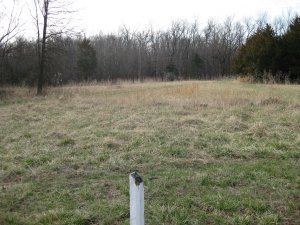
Just a little bit south of Trail Marker 6 is a memorial to the 600 Confederate casualties. The flag on the marker is the Missouri Battle Flag.

Following the trail south to Trail Marker 7 will bring you to the Lieutenant Colonel Frederick W. Benteen Memorial Footbridge.

Previous slide
Next slide
Stop 7
Lathrop Cabin
DIRECTIONSLathrop Cabin
Off in the distance to the southeast was the cabin of a Mrs. Lathrop. The cabin stood just about where the house that you see stands today. According to Hinton, a Mrs. Lathrop stood with young children in front of her log cabin and shouted, "God bless you, boys! God bless you boys! Hurra for the Union! Hurra for Kansas! Give it to 'em." After the battle, the area in and around the cabin was used as a field hospital. When this occurred, Mrs. Lathrop took the children north to the Ragain's house which was located near the Mound City Road (now State Highway 52).
It was the morning of October 25, 1864. The situation for Price's Army was precarious. It was strung out over a distance of 8 miles from Mine Creek to the Little Osage River. Price himself was encamped at the head of the column about eight miles south along with Shelby's Division. He planned to attack Fort Scott and capture what government stores were there. Marmaduke's Division had been given responsibility as rear guard for the retreating Confederate army. Marmaduke was back at Mine Creek dealing with a difficult situation there.
Around 11:00 A.M. Marmaduke found that the Mine Creek crossing was blocked. Because of the heavy rains, the creek was a raging torrent. The two available fords were backed up with over 100 wagons still trying to get across. To further complicate matters, a wagon had overturned and was now blocking the ford. Marmaduke had planned to get across and set up his rear-guard defense on the south side of Mine Creek. But now Marmaduke knew he needed to hold off the advancing Federals from the north bank until the remaining wagons could get across the creek. He sent word back to get support from Fagan's division.
Previous slide
Next slide
Stop 8
Main Ford Over Mine Creek
DIRECTIONSMain Ford Over Mine Creek
Now you are standing at the main ford over Mine Creek. If the water is not too deep, you will be able to see that the creek has a rocky bottom.
But remember that on October 25, 1864, there had been wet weather and the creek had risen. Mine Creek is a small stream but the ford along the Fort Scott Road was difficult and dangerous. Both banks were steep (10 to 25 feet) and treacherous. The ford had a rocky bottom but the far side bank was steep and was now slippery after most of Price's wagon train had already gotten across. There were two other fords but they both had muddy bottoms and were not passable by wagons during wet weather. The main reason that Marmaduke had established his defense line north of the creek was because a large part of the wagon train had still not been able to get across the creek. Around 11:00 A.M. Marmaduke had found that the Mine Creek crossing was blocked. Because of the heavy rains the creek was a raging torrent. The two available fords were backed up with over 100 wagons still trying to get across. To further complicate matters, a wagon had overturned and was now blocking the main ford.
After the Federal cavalry charge broke through the Confederate lines, units from Benteen's Brigade were able reach Mine Creek and block the fords. This added further to the confusion and disarray of the retreating Confederates who had difficulty escaping across the creek because of the steep banks.
Previous slide
Next slide
Stop 9
Palmer House
DIRECTIONSPalmer House
You are now standing north of where the house belonging to John Palmer stood just on the other (south) side of the creek. Before the battle began, Major General James F. Fagan had deployed parts of his division south of the creek in and around the Palmer House. The house itself was less than 100 yards from the south bank of the main ford. Mrs. Palmer and her two daughters along with Barbara Jane Dolson and her infant daughter were at the house when the Confederates first moved through on their way south. After the battle was over, they were outside offering assistance to the wounded.
"The advance of the rebel army (a squad of Shelby's men) reached our house just as breakfast was ready. The few who came in first sat down to the table and went to helping themselves. The house was then soon full of rebels. I went to the door and looked out; the whole valley seemed full of men. The first that passed seemed to be marching in some order. At the head of the column was an old rebel flag all torn in strips, fluttering in the wind. But as they came on they seemed to be in more and worse confusion, and traveling faster, until as the last wagon train passed they were in great confusion and going at a dead run. This was the supply train which they were anxious to save from the attacking Union forces. Soon the cannon began to boom and we could see the rebels forming in battle line just north of our house, and only a few rods distant. Standing in the north door I could see a great mass of men and horses coming swiftly on; soon the rattle of musketry was so great I could hear nothing else. I could see cannons a mile away belch out flames and smoke but could not hear them for the noise of the small arms all around me."
- Barbara Jane Dolson's description
Previous slide
Next slide
Stop 10
Marmaduke and Cabell Captured
DIRECTIONSMarmaduke and Cabell Captured
You are now standing in the middle of where Cabell's Brigade was deployed. Remember that once the Federal Cavalry charged it took only 15 to 20 minutes for them to break the Confederate lines in multiple places.
All during the fierce fighting, Major General John S. Marmaduke kept on trying to rally his troops to fight off the attacking Federals. It was during this time while Marmaduke was trying to rally his troops that he came to be captured by Private James Dunlavy of Company D of the Third Iowa Cavalry. Dunlavy took his prize north and turned him over to Colonel Charles W. Blair of the Third Brigade in Blunt's Division. Blair presented Marmaduke to General Curtis who was at the Ragain's house on the Mound City Road (present State Highway 52).
Brigadier General William L. Cabell soon realized that the Confederate line was being routed. Being surrounded, he gathered a small group of troops and tried to break through the Federals south of this position in order to get to and across Mine Creek. Cabell reached the creek and tried to get across, but his horse could not get up the steep bank and fell back. At this point he was captured by a squad from the Seventh Missouri State Militia Cavalry. The Federals did not realize that Cabell was a general and Cabell was able to escape. This time he was captured by Sergeant Cavalry N. Young of Company L of the Third Iowa Cavalry Regiment. Still not knowing they had captured a general officer, Cabell managed to escape again. But he ended up being captured yet a third time by Young's squad. Young finally discovered who Cabell was and immediately escorted him to the rear.
Both Young and Dunlavy were later awarded the Congressional Medal of Honor for their actions. Colonel W. F. Slemmons, commander of Slemmons' Brigade in Fagan's Division, was also captured. All the colonels in Cabell's Brigade were casualties that day.
Previous slide
Next slide
Stop 11
Battle Aftermath
DIRECTIONSBattle Aftermath
Few Federals were involved in the cleanup after the battle and many Confederate prisoners escaped. There was considerable indiscriminate killing of prisoners. No Kansas Militia units were present, but there were many individual militiamen that had gone to the front to exact revenge for what they considered to have been Confederate atrocities. Many of the Confederates being taken prisoner were wearing the Federal uniforms captured earlier in Glasgow, Missouri. In his official report, Colonel Philips stated that some captured Confederates were executed because they were wearing Federal uniforms. Some of the Union troopers had had comrades killed by Shelby's men at the Osage. The Missouri State Militia were under orders to execute Confederates, primarily guerrillas, who attacked wearing Union uniforms. Some had been in the Indian Territory in September when General Gano's men had killed Union prisoners. It is highly likely that both Curtis and Pleasanton knew of these killings but chose to ignore them.
Confederate casualties - 500 captured, at least 200 (possibly 300-400) killed, and 200 seriously wounded
Federal casualties - 8 killed and 56 seriously wounded
Federal casualties - 8 killed and 56 seriously wounded
Meanwhile, units from Philips' and Benteen's Brigades crossed Mine Creek in pursuit of the fleeing Confederates. Fagan attempted to make a delaying action about a mile south of Mine Creek. But as Philips' prepared to attack, Fagan withdrew his forces south. At this time, Pleasanton had ordered Philips to halt the pursuit until reinforcements could be brought forward. But both Sanborn and McNeil were several miles north of Mine Creek and were very slow to move south. Blunt's Division was still north of the Marais des Cygnes River. He was slow moving because he was angry at having been removed from the advance of the Federal pursuit column. Once again the Federal pursuit stalled.
Marmaduke's and Fagan's Divisions were completely demoralized - some referred to this as the "Stampede on the Prairie" These divisions had lost over 1,000 men, all their artillery and many small arms.
Thank you for learning more about this site and its unique significance hosting a large cavalry battle! Follow the trail back to the Visitor Center. You will walk past a couple of interpretive markers to read along the way. For even more research about local civil war battles in the Trans-Mississippi Theatre, see Dick Titterington’s books on Amazon or his website.
Previous slide
Next slide